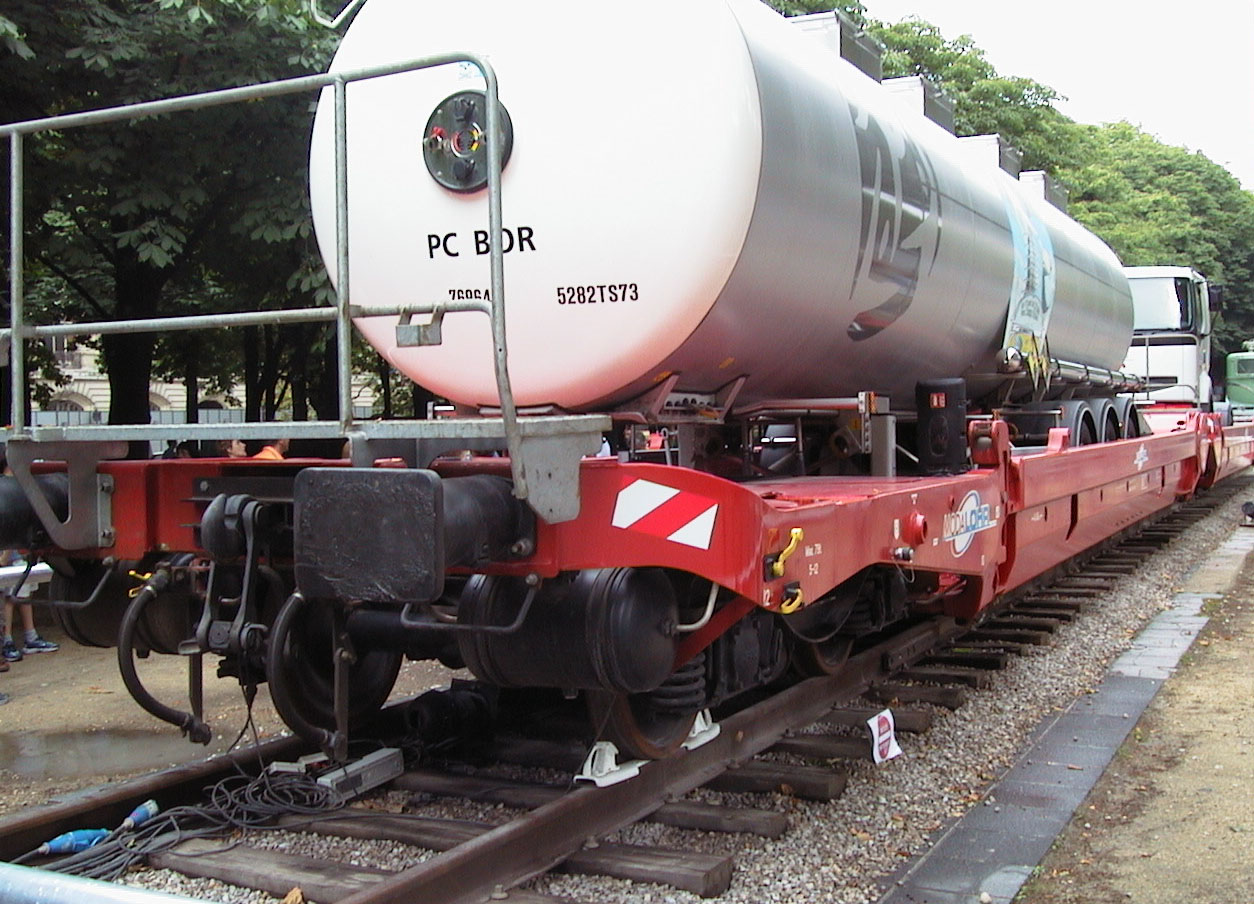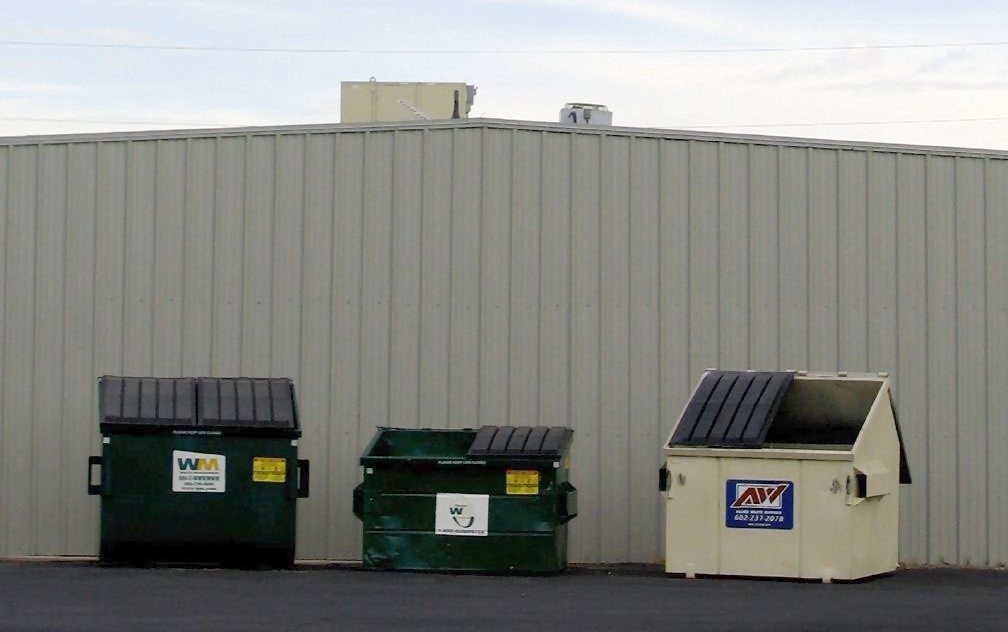|
Roller Container
A roller container is a container type that can be carried by trucks to be pushed to ground level by help of a hook and level arm with the container possibly sliding on steel roller wheels. Its original usage was in the collection of bulk waste resulting in the creation of the DIN standards to be initiated by city cleaning companies. An additional part defines a transport frame mounted on specialized rail cars that allows easy intermodal transport for these container types. Another important area is in the containerization of firefighting equipment used as swap body containers of fire trucks. Etymology The term "roller container" has been introduced in the English summary of the DIN standards that refer to the prominent feature of steel wheels - such wide wheels are commonly known in English as rollers. It does also refer to the verb "to roll" which has the same meaning in German - the particle "ab-" in German "abroll container" designates downward/pushback operations so that ... [...More Info...] [...Related Items...] OR: [Wikipedia] [Google] [Baidu] |
Swap Body
A swap body, swop body, exchangeable container or interchangeable unit, is one of the types of standard freight containers for road and rail transport. Based on and very similar to the more widespread shipping containers (ISO containers), swap bodies normally have the same external dimensions for the bottom corner fittings as ISO shipping containers so that they can be placed on the same kinds of trucks, trailers and railroad cars designed for shipping containers. However, ISO containers inner dimensions (2.33 m wide) are just a few centimetres too short to accommodate European-pool pallets () without leaving much empty space. To optimise the carriage of pallets, wide bodies are often scaled to the maximum width allowed for standard road trucks and railroad cars and to a different length without leaving empty space. On the other hand, swap bodies do not have upper corner fittings, are not stackable and must be lifted by the bottom frame. Thus, they require special handling when ... [...More Info...] [...Related Items...] OR: [Wikipedia] [Google] [Baidu] |
Sidelifter
A sidelifter is a specialised vehicle or semi-trailer used to hoist and transport ISO standard intermodal containers over longer distances. Overview The sidelifter loads and unloads containers via a pair of hydraulic powered cranes mounted at each end of the vehicle chassis. The cranes are designed to lift containers from the ground, from other vehicles including rolling stock, from railway wagons and directly from stacks on docks or aboard container ships. A standard sidelifter is also able to stack a container at a two containers' height on the ground. If the sidelifter chassis is of 40' length or more, the cranes of the sidelifter can be shifted hydraulically along the sidelifter chassis to be able to pick up either one 20', one 40', or two 20' ISO containers at a time. As the Sidelifter is suitable for travelling on general roads for large distances and able to quickly load and unload without additional equipment, it is often used for delivering and picking up shipping contai ... [...More Info...] [...Related Items...] OR: [Wikipedia] [Google] [Baidu] |
Roll-off (dumpster)
In North America, a roll-off is a usually open top dumpster characterized by a rectangular footprint, utilizing wheels to facilitate rolling the dumpster in place. The container is designed to be transported by special roll-off trucks. There are two types of delivery trucks for the bins based on bin size and they are: Hook lift bins and Roll-off bins. Roll-offs are commonly used to contain loads of construction and demolition waste or other waste types. While most roll-off containers have a swinging door on the end for easier disposal of waste, some roll-off containers are not open top and are used with commercial or industrial trash compactors. Construction debris may originate from a building site where something is being built, renovated, or demolished. Roll-off dumpsters are also used for various jobs that need much material to be taken away. The material in the roll-off may be taken to a landfill, recycled or disposed/recovered of in some other way. Size Roll-off contain ... [...More Info...] [...Related Items...] OR: [Wikipedia] [Google] [Baidu] |
Modalohr
The Lohr Railway System or Modalohr System (french: Système Modalohr) uses special railway wagons of a type known as piggyback wagons, to carry standard road semi-trailers on the European rail network.''Lohr Railway System'' at lohr.fr. Retrieved 23 Jun 2017. They are currently used on the AFF route from to and to the French border with Spain and vice versa. There are plans to expand this servic ... [...More Info...] [...Related Items...] OR: [Wikipedia] [Google] [Baidu] |
Dumpster
A dumpster is a movable waste container designed to be brought and taken away by a special collection vehicle, or to a bin that a specially designed garbage truck lifts, empties into its hopper, and lowers, on the spot. The word is a generic trademark of ''Dumpster'', an American brand name for a specific design. Generic usage of ''skip'' or ''skip bin'' is common in the UK, Australia and Ireland, as Dumpster is neither an established nor well-known brand in those countries. History The word "dumpster", first used commercially in 1936, came from the Dempster-Dumpster system of mechanically loading the contents of standardized containers onto garbage trucks, which was patented by Dempster Brothers in 1935. The containers were called ''Dumpsters'', a blending of the company's name with the word ''dump''. The Dempster Dumpmaster, which became the first successful front-loading garbage truck that used this system, popularized the word. The word ''dumpster'' has had at least three ... [...More Info...] [...Related Items...] OR: [Wikipedia] [Google] [Baidu] |
CargoBeamer
Cargobeamer is an intermodal transport system. It involves specially designed pallets which can be carried on a road trailer; the pallets are fitted on top of flatcars but can slide sideways to allow trucks to drive on and off smoothly at intermodal terminals. A first testing terminal was opened in Leipzig in Germany; trial runs between Leipzig and Lithuania were planned in November 2010. Since July 2021, the first full CargoBeamer terminal is availlable to the public transport market in Calais, France. CargoBeamer Routes The company advertises several routes: * Kaldenkirchen – Domodossola (, 17 hours) * Calais – Perpignan (, 24 hours) * Calais – Domodossola (, 19 hours) * Kaldenkirchen – Perpignan (, 30 hours) CargoBeamer Terminals Calais (France) The first full CargoBeamer terminal was opened in Calais in July 2021 with a first connection to Perpignan in Southern France. Later that year, a second lane to Domodossola in Italy was added. Domodossola (Ital ... [...More Info...] [...Related Items...] OR: [Wikipedia] [Google] [Baidu] |
Demountable Rack Offload And Pickup System
The Demountable Rack Offload and Pickup System (DROPS) is a family of logistics vehicles operated by the British Army, which consists of two vehicle types: * Leyland DAF medium mobility load carrier (MMLC) * Foden improved medium mobility load carrier (IMMLC) Both are able to transport 15-tonne flatracks or containers configured to ISO 20 feet standard and to load and offload them autonomously. Both may be supported with side rail transfer equipment (SRTE) for loading and unloading railway wagons. The DROP system was designed to meet the very high intensity battles in Central Europe in the last decade of the Cold War. However it entered service after the collapse of the Warsaw Pact but nevertheless proved a versatile vehicle system on operations completely different from those originally envisaged. Operational requirement The DROP system developed from the revaluation of readiness and firepower requirements of British Army of the Rhine (BAOR) in the mid-1970s. This was driven by ... [...More Info...] [...Related Items...] OR: [Wikipedia] [Google] [Baidu] |
Palletized Load System
The Palletized Load System (PLS) is a truck-based logistics system that entered service in the United States Army in 1993. It performs long and short distance freight transport, unit resupply, and other missions in the tactical environment to support modernized and highly mobile combat units. It provides rapid movement of combat configured loads of ammunition and all classes of supply, shelters and intermodal containers. It is similar to systems such as the British Demountable Rack Offload and Pickup System (DROPS). History In January 1989, the United States Army Tank Automotive Command awarded prototype PLS contracts to Oshkosh Truck Corporation, the PACCAR Government Group and General Motors, Military Vehicle Operations, with each contractor to deliver nine trucks, six trailers, and 30 flatracks for prototype hardware testing which began in September 1989. Oshkosh Truck Corporation was awarded a five-year contract for PLS in September 1990, with production commencing in 1992 ... [...More Info...] [...Related Items...] OR: [Wikipedia] [Google] [Baidu] |
M1120 HEMTT Load Handling System
The M1120 HEMTT LHS (Load Handling System) is a M977 Heavy Expanded Mobility Tactical Truck with a load handling system in place of a flat bed/cargo body. The HEMTT is an eight-wheel drive, diesel-powered, tactical truck used by the US military and others. The HEMTT is manufactured by Oshkosh Defense and entered Army service in 1982, with the M1120 variant first produced in 1999. History Following the evaluation of proposals submitted by AM General, MAN, Pacific Car & Foundry (PACCAR) and Oshkosh Truck Corporation, In May 1981, the then U.S. Army Tank Automotive Command awarded an initial five-year contract valued at US$251.13 million to Oshkosh Truck Corporation for production of the 10 ton (9,070 kg) 8 x 8 Heavy Expanded Mobility Tactical Truck (HEMTT). The M1120 LHS variant was initially introduced as part of the HEMTT overhaul/rebuild programme, during which returned M977 Cargo variants have their cargo bodies and materials handling cranes removed, to be replaced by a Mul ... [...More Info...] [...Related Items...] OR: [Wikipedia] [Google] [Baidu] |
Heavy Expanded Mobility Tactical Truck
The Heavy Expanded Mobility Tactical Truck (HEMTT) is an eight-wheel drive, diesel-powered, tactical truck. The M977 HEMTT first entered service in 1982 with the United States Army as a replacement for the M520 Goer, and since that date has remained in production for the U.S. Army and other nations. By Q2 2021, around 35,800 HEMTTs in various configurations had been produced by Oshkosh Defense through new-build contracts and around 14,000 of these had been re-manufactured. Current variants have the A4 suffix. The 10×10 Logistic Vehicle System Replacement (LVSR) is the United States Marines Corps' (USMC) equivalent to the U.S. Army's 8×8 HEMTT and 10×10 Palletized Load System (PLS). The USMC do not use the HEMTT or PLS, and the Army does not use the LVSR, but both services use a common trailer (M1076) with all three truck types. History Following the evaluation of proposals submitted by AM General, MAN, Pacific Car & Foundry (PACCAR) and Oshkosh Truck Corporation (with P ... [...More Info...] [...Related Items...] OR: [Wikipedia] [Google] [Baidu] |






